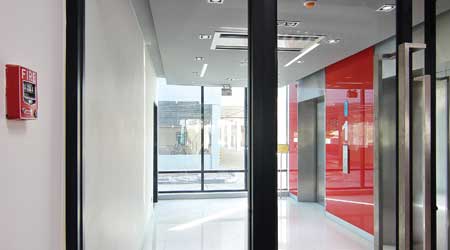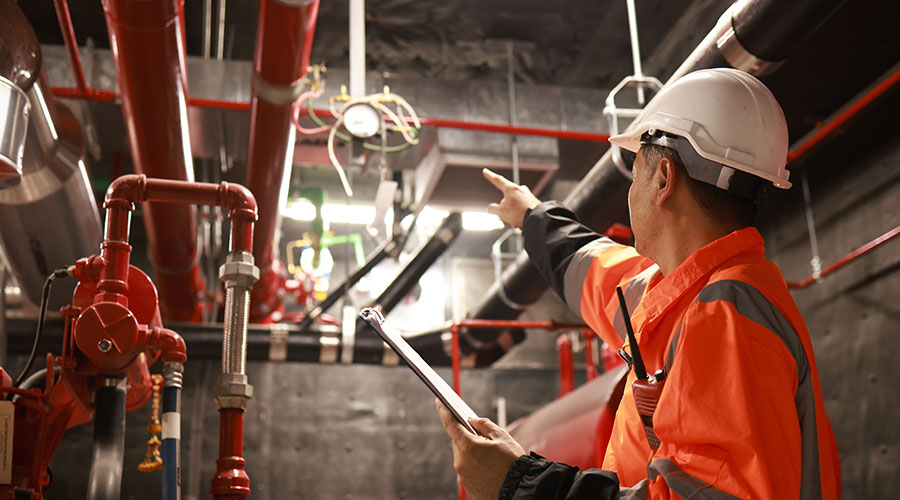 Fire safety system design must address critical interconnected emergency control equipment and wiring to fans, dampers, smoke control equipment, and elevators.
Fire safety system design must address critical interconnected emergency control equipment and wiring to fans, dampers, smoke control equipment, and elevators.Does Your Fire Alarm System Need an Upgrade or Replacement?
Consider several questions when evaluating your fire alarm system for upgrade or replacement, among them age, functionality, control equipment, and many more.
There are many reasons that a fire alarm system might need to be replaced. For example, any fire alarm system installed prior to the year 2000 would generally need an upgrade or replacement plan. The same is true if you have a newer system that is starting to experience nuisance alarms, has outstanding recall items or warranty issues, or is experiencing wiring and device troubles. If you are in any of these situations, what should you consider before repairing or replacing a fire alarm system? Let’s examine the process of upgrading or replacing a system.
Upgrade or replace?
The first step is to answer the question, “Does my fire alarm system need to be upgraded or completely replaced?” This is directly related to the challenges you are facing with the system. Perhaps, due to a lack of funds, maintenance is always deferred, and thus systems are overdue for needed replacement. Perhaps you believe that, because your buildings are always occupied, they cannot have their systems upgraded in an owner- or occupant-acceptable manner. Perhaps you do not have an existing system inventory or code-compliance audit or analysis for these important systems, so you do not really understand what funds and time will be needed. Or maybe you are concerned that, due to building changes, they cannot be replaced or upgraded in a compliant manner without an extremely complicated effort, possibly even requiring closing operations during the replacement.
Regardless of these concerns, the fact remains that an upgrade or replacement is necessary. The danger of waiting until a system or a significant component fails is that you then have to make an emergency replacement, which always costs significantly more than a planned replacement. A building owner may not want to budget for a fire alarm upgrade or replacement, but they most certainly do not want to pay for fire watch, overtime installation, and other similar emergency replacement costs.
Start with a complete audit of your fire alarm system. If you do not feel qualified to perform this audit, get assistance from a knowledgeable fire protection professional. The audit should include a complete evaluation of the fire alarm system, including the head-end equipment, initiating devices, notification appliances, and control interfaces. This audit should capture the infrastructure (interconnection methodology) of control equipment, the condition of the installed cabling, the age, location, and model numbers of the detection equipment, and the layout of the notification appliances. Additionally, the review should note any obsolete equipment, recalled equipment, or equipment that has no modern replacement part due to size or function. It is also important to note if signals from your fire alarm system are monitored by an off-premise service like a remote supervising station or central station. If so, the details of how that off-premise signal is routed and handled should be recorded to identify opportunities for improvement.
It is also important to review the operation of your building as it is currently being used. Has the construction or occupancy use changed since the fire alarm system was installed? Did any building modifications cause the existing system to be non-code compliant? Perhaps there are portions of your building that need to be redesigned from a fire alarm perspective due to occupancy use.
Also, consider the inspection, test, and maintenance (ITM) needs of your facility. It does no good to upgrade or replace a fire alarm system if you have no long-term plan in place to provide quality inspection, test, and maintenance of the new or upgraded system. It is, in fact, the only way to receive the full value of the costs involved. It is also important to include the vendor (manufacturer’s representative) of your system in your inspection, test, and maintenance plans, as that is the only way to receive important software and firmware updates and required programming changes demanded by modern fire alarm systems. This is also true of any attempt to upgrade a fire alarm system; the manufacturer’s representative is needed to provide accurate information and provide valuable warranties to the changes made.
One more point to note if your upgrade or replacement is moving from a non-voice (horn-based) system to a voice fire alarm system. Some occupancies, like educational occupancies, formerly did not require voice fire alarm systems, but now do require them. As a result, many facilities are (and should be) deciding to provide better upgraded coverage for fire and other types of emergencies. It is important in this situation to record the existing notification appliance layout in its entirety and then consider the direction in NFPA 72 regarding acoustically distinguishable spaces. A qualified designer needs to review your facility in detail in order to meet the current intelligibility requirements, which were not included within the code prior to 2010. Never allow anyone to convince you that a one-for-one horn for loudspeaker design will produce a design that is intelligible. Any voice/audio system must be thoroughly reviewed so that any upgrade or replacement system provides an audible and intelligible loudspeaker design.
Related Topics:














